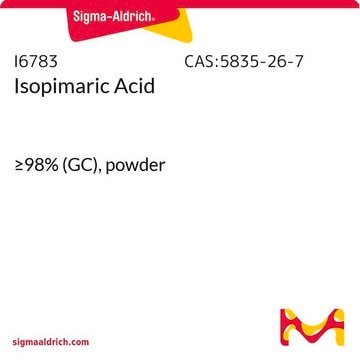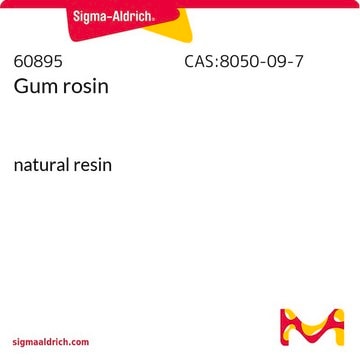Wichtige Dokumente
SMB00089
Dehydroabietic acid
≥90% (LC/MS-ELSD)
Synonym(e):
Abieta-8,11,13-trien-18-oic acid, Dehydroabietate
Größe auswählen
About This Item
Empfohlene Produkte
Assay
≥90% (LC/MS-ELSD)
Form
solid
Anwendung(en)
metabolomics
vitamins, nutraceuticals, and natural products
Lagertemp.
−20°C
SMILES String
CC(C)c1ccc2c(CC[C@H]3[C@@](C)(CCC[C@]23C)C(O)=O)c1
InChI
1S/C20H28O2/c1-13(2)14-6-8-16-15(12-14)7-9-17-19(16,3)10-5-11-20(17,4)18(21)22/h6,8,12-13,17H,5,7,9-11H2,1-4H3,(H,21,22)/t17-,19-,20-/m1/s1
InChIKey
NFWKVWVWBFBAOV-MISYRCLQSA-N
Verwandte Kategorien
Allgemeine Beschreibung
Anwendung
- to study the aging process of Pinus resins using Fourier-transform infrared spectroscopy (FTIR)[3]
- to study the composition changes in Pinus genus with aging using Raman spectroscopy complemented with infrared spectroscopy[4]
- to estimate resistance against biotic stress as proxy in chemical defenses in Pinus halepensis[5]
Biochem./physiol. Wirkung
Signalwort
Danger
H-Sätze
P-Sätze
Gefahreneinstufungen
Acute Tox. 3 Oral - Aquatic Acute 1 - Aquatic Chronic 1
Lagerklassenschlüssel
6.1C - Combustible acute toxic Cat.3 / toxic compounds or compounds which causing chronic effects
WGK
WGK 1
Flammpunkt (°F)
Not applicable
Flammpunkt (°C)
Not applicable
Hier finden Sie alle aktuellen Versionen:
Analysenzertifikate (COA)
Die passende Version wird nicht angezeigt?
Wenn Sie eine bestimmte Version benötigen, können Sie anhand der Lot- oder Chargennummer nach einem spezifischen Zertifikat suchen.
Besitzen Sie dieses Produkt bereits?
In der Dokumentenbibliothek finden Sie die Dokumentation zu den Produkten, die Sie kürzlich erworben haben.
Kunden haben sich ebenfalls angesehen
Aktive Filter
Unser Team von Wissenschaftlern verfügt über Erfahrung in allen Forschungsbereichen einschließlich Life Science, Materialwissenschaften, chemischer Synthese, Chromatographie, Analytik und vielen mehr..
Setzen Sie sich mit dem technischen Dienst in Verbindung.












